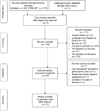Poor Gait Performance and Prediction of Dementia: Results From a Meta-Analysis
- PMID: 26852960
- PMCID: PMC5319598
- DOI: 10.1016/j.jamda.2015.12.092
Poor Gait Performance and Prediction of Dementia: Results From a Meta-Analysis
Abstract
Background: Poor gait performance predicts risk of developing dementia. No structured critical evaluation has been conducted to study this association yet. The aim of this meta-analysis was to systematically examine the association of poor gait performance with incidence of dementia.
Methods: An English and French Medline search was conducted in June 2015, with no limit of date, using the medical subject headings terms "Gait" OR "Gait Disorders, Neurologic" OR "Gait Apraxia" OR "Gait Ataxia" AND "Dementia" OR "Frontotemporal Dementia" OR "Dementia, Multi-Infarct" OR "Dementia, Vascular" OR "Alzheimer Disease" OR "Lewy Body Disease" OR "Frontotemporal Dementia With Motor Neuron Disease" (Supplementary Concept). Poor gait performance was defined by standardized tests of walking, and dementia was diagnosed according to international consensus criteria. Four etiologies of dementia were identified: any dementia, Alzheimer disease (AD), vascular dementia (VaD), and non-AD (ie, pooling VaD, mixed dementias, and other dementias). Fixed effects meta-analyses were performed on the estimates in order to generate summary values.
Results: Of the 796 identified abstracts, 12 (1.5%) were included in this systematic review and meta-analysis. Poor gait performance predicted dementia [pooled hazard ratio (HR) combined with relative risk and odds ratio = 1.53 with P < .001 for any dementia, pooled HR = 1.79 with P < .001 for VaD, HR = 1.89 with P value < .001 for non-AD]. Findings were weaker for predicting AD (HR = 1.03 with P value = .004).
Conclusions: This meta-analysis provides evidence that poor gait performance predicts dementia. This association depends on the type of dementia; poor gait performance is a stronger predictor of non-AD dementias than AD.
Keywords: Epidemiology; dementia; gait disorders/ataxia; motor control.
Copyright © 2016 AMDA – The Society for Post-Acute and Long-Term Care Medicine. Published by Elsevier Inc. All rights reserved.
Conflict of interest statement
The authors declare no conflicts of interest.
Figures



References
-
- Verghese J, Lipton RB, Hall CB, et al. Abnormality of gait as a predictor of non-Alzheimer’s dementia. N Engl J Med. 2002;347:1761–1768. - PubMed
-
- Alexander NB. Gait disorders in older adults. J Am Geriatr Soc. 1996;44:434–451. - PubMed
-
- Odenheimer G, Funkenstein HH, Beckett L, et al. Comparison of neurologic changes in ‘successfully aging’ persons vs the total aging population. Arch Neurol. 1994;51:573–580. - PubMed
-
- Nutt JG. Classification of gait and balance disorders. Adv Neurol. 2001;87:135–141. - PubMed
Publication types
MeSH terms
Grants and funding
LinkOut - more resources
Full Text Sources
Other Literature Sources
Medical

